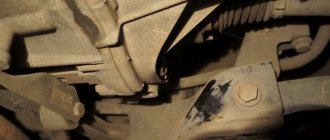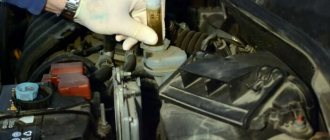The Chevrolet Lacetti manufacturer implies that replacing the transmission lubricant is necessary only in case of transmission repair. There is not even a drain hole in the pan. But the experience of car enthusiasts suggests that severe operating conditions, for example, driving on rough roads, traffic jams and low temperatures, quickly wear out the lubricant. As a result, the oil loses its protective properties, and the gearbox mechanism begins to collapse. This affects operation by poor gear shifting, knocking and noise from the gearbox.
Do-it-yourself recommendations for changing the oil in a Chevrolet Lacetti manual transmission.
Therefore, timely replacement of lubricant is a necessary measure in order to prevent malfunctions and extend the service life. An incorrectly performed procedure will result in damage to the transmission unit. Changing the oil in a Lacetti box can be done either at a service station or independently if you have a little skill.
Checking the oil level and condition
You need to check the oil level of the Chevrolet Lacetti manual transmission at every maintenance, as well as if there are signs of deterioration in performance. The check must be performed on a cold gearbox. To do this, place the car on an inspection hole, overpass or lift. The engine protection is removed. The inspection hole is located between the rear support of the power unit and the wheel drive on the right side. Use a 13 mm socket wrench to unscrew the plug and assess the fluid level in the transmission. It is considered sufficient to lower the level no more than four millimeters from the edge of the hole. If there is insufficient oil, you need to figure out the cause of the leak and add the required amount.
Selection of oil by parameters
We will not delve too deeply into the topic of oil parameters, and will consider only the most optimal options. Especially for the Chevrolet Lacetti manual transmission, we can recommend Ravenol 75W90 Getriebeoel TSG GL-4 oil. This is a semi-synthetic product, which will be the best option in terms of price-quality ratio. Of course, this lubricant is much more expensive than pure mineral oil, but it has more stable beneficial properties - both at low and high temperatures. Let us highlight the following advantages of the product from Ravenol:
- Protection of manual transmission components from premature wear
- Effective cooling of all transmission parts
- Stable operation of the box under increased load
- Optimal viscosity level, adapted even to temperatures above 40 degrees
- High thermal stability
- Adaptability to extremely low temperatures
- Good compatibility with elastomers, namely resistance to the spread of corrosion
- Reducing the effect of “dry friction” of parts
- Affordable price
Which oils are better to choose?
The decision to change the old fluid immediately can cause the problem of choosing a new one. The fact is that the manufacturer does not indicate what original oil is poured into the manual gearbox. What kind of oil should I use? Dealers' opinions on this matter vary. Most experts recommend using Ravenol 75W90 API Gl-4 liquid. If this type is not available, fill in analogues: GM 75W90, Castrol Syntrans 75W90. We use only synthetics in the mechanics for good transmission performance. In this case, the transmission oil will last for a longer period of operation.
Features and Recommendations
In fact, changing the oil in a Lacetti gearbox is simple, but certain conditions must be met:
- The gearbox does not have a drain neck, so the operation takes a little longer than a similar one on another car.
- In addition to the oil, it is necessary to replace the pan cover gasket. You need to be careful, as there are two types of gaskets - for 10 mounting holes and for 11. Before purchasing, it is recommended to clarify which gasket your car needs.
- It is best to change mineral oils every 50-60 thousand kilometers, and synthetic oils every 120-150 thousand kilometers.
- According to numerous reviews from drivers, the most optimal oil for the Lacetti is SAE 75W-80(90) API GL-4.
The operation is best carried out in a viewing hole.
Complete oil change
Before draining the used fluid into the Chevrolet Lacetti gearbox, the car should be warmed up to operating temperature. Changing the oil in the box with your own hands is done on an overpass, inspection pit or on a lift. The procedure differs from other brands in that the Lacetti does not have a drain hole. Changing the oil in a Chevrolet Lacetti manual transmission consists of the following steps:
- Place the car on the inspection hole.
- Find the breather under the hood and unscrew it. This is necessary for maximum oil flow.
- Under the car, find and unscrew the manual transmission inspection hole plug.
- Prepare a container for the waste liquid.
- Using a 13 mm spanner, loosen the pan mounting bolts.
- Use a screwdriver to pry the pan so that the lubricant begins to pour out.
- After draining, remove the pan with the remaining grease.
- Wait until the liquid is completely drained.
- Wipe and clean the pan and crankcase surface.
- Lubricate the adjacent surfaces of the sump and manual transmission housing with sealant.
- Install a new gasket.
- Carefully tighten the mounting bolts.
- Wait for the time indicated on the sealant package to cure.
- In the engine compartment, use a syringe to fill in new oil until it begins to pour out through the inspection hole.
- Replace the breather.
- Check the lubricant level again.
After a few days, check for possible leaks. Next, check the fluid level every fifteen thousand kilometers.
Selecting transmission oil
When choosing transmission fluid, you must consider the following basic principles:
- SAE specification - determines the thermal stability of the oil. The temperature-viscosity qualities of the oil depend on the ambient temperature. The SAE indicator determines in what temperature range the composition can be used for efficient operation of the unit.
- ·API tolerances – detailed recommendations on the applicability of products to a transmission of a certain type and transmission mechanism.
- Type of lubricant – mineral water, semi-synthetic, synthetic.
The following brands of oils are suitable for changing the oil in a Chevrolet Lacetti manual transmission:
- Mobil ATF 3309. Used in automatic transmissions with controlled slip lock. Maintains manual transmission cleanliness at factory condition.
- ISU DEXRON III. Suitable for most Chevrolet Lacetti automatic transmissions with servo drive and anti-slip lock. Meets and exceeds the latest requirements of the world's leading DEXRON manufacturers from GM.
- Castrol Manual EP SAE 80W-90. Transmission oils based on mineral oils purified by catalytic hydrocracking.
- Mobil ATF LT 71141. Semi-synthetic ATF product for robotic, automatic transmissions. Optimal frictional properties of the fluid ensure smooth gear shifting.
How much oil should be filled
According to the instructions for this car, you need to fill in 1.8 liters. But as practice shows, about 1.5 liters are poured. This is explained by the fact that when the oil is drained, about 200-300 ml of old oil remains inside the drain area. And accordingly, to reach the optimal level, it is necessary to add another 1.5 liters. Some fill the entire volume, but you need to remember that if the drain is insufficient, the oil level may rise above the optimal level and lead to overflow.
Gearbox in the Chevrolet Lacetti, problems and their solution
Each owner of a Chevrolet Lacetti may be faced with the need to dismantle the gearbox of their car and change the oil in it. A practical solution would be to learn how to do these manipulations yourself in order to insure yourself in case of unforeseen situations.
Transmission related problems
When operating a car, the Chevrolet Lacetti gearbox can cause a number of problems. These may be problems of the following types:
- Noises appear when changing gears in the car;
- An increase in fuel consumption when driving around the city that is unexplained by objective reasons;
- Clutch cylinders are leaking;
- Long stroke;
- Incorrectly selected gear ratios.
According to statistics, every second owner of a Chevrolet Lacetti is faced with the problem of long travel. To put it another way, the longer the car continues to move in one gear, without shifting, the longer the gearbox is considered to have a longer travel. The opposite is also true. The driver experiences certain inconvenience due to this circumstance, since he constantly has to keep the engine speed under control.
Another feature that can cause inconvenience to the driver is unclear gear engagement.
There are a few more points: the box may crunch when changing gears at low sub-zero temperatures; reverse gear may not be engaged immediately, but after some time; the handle stroke becomes uncomfortable in second and third gear.
In order not to encounter such unpleasant moments in the operation of the car, you need to constantly keep its technical condition under control.
First of all, you need to keep the oil level in the Chevrolet Lacetti gearbox under control. Operation with a low oil level will lead to very rapid wear of vehicle parts and failure.
The inspection pit is used to diagnose the box for leaks. Leaks typically occur in the following places:
- Differential cover;
- Connection points between the drive joints and the gearbox;
- Connections between the cylinder block and crankcase;
- Gear shift rod.
If you observe any of the above in your Chevrolet Lacetti, it means that the box requires repair, for which you need to dismantle it. Below you will find instructions for dismantling the box, as well as for installing it back after repair.
Instructions for dismantling the gearbox
This procedure may be necessary to repair the box or replace drive parts. Dismantling the box is a rather labor-intensive procedure that requires skills and special equipment. Ideally, it is better for these manipulations to be performed by car service employees. The weight of the box is about 30 kg, so you will need the help of another person or you need to use a special lifting device.
- Remove the battery and shelf;
- Remove the gear shift drive assembly;
- Remove the drive shaft;
- We disconnect the electrical connectors at the reverse light switch;
- We disconnect the electrical connectors at the speedometer sensor;
- We take out the hairpin;
- Remove the clutch release cylinder tube;
- Remove the connecting nut;
- Remove the damping block bolt;
- Unscrew the bolts of the rear suspension bracket;
- Remove the bracket from the rear suspension;
- Unscrew the bolts securing the rear damping block;
- Remove the rear block;
- Unscrew the casing bolts;
- Remove the bolts securing the upper bracket;
- Remove the bracket;
- Unscrew the bolts securing the box;
- We select the box with a jack;
- Unscrew the lower mounting bolts;
- Remove the box;
- We move the box towards the engine;
- We lower the box.
Gearbox Installation Instructions
- Support the box on a jack;
- Insert the input shaft into the clutch disc;
- Move the box sideways towards the car engine;
- Tighten the lower mounting bolts;
- Tighten the upper mounting bolts;
- Install the casing and screw in the bolt;
- Install the upper suspension bracket and tighten the bolts;
- Tighten the rear damping block bolts;
- Install the rear block;
- Install the rear bracket and tighten the bolts;
- Install the coupling nut and bolt of the damping block;
- Connect the clutch release cylinder tube;
- Connect the electrical connector of the speedometer sensor;
- Connect the reverse light switch connector;
- Remove the device used to hang the engine;
- Install the drive shaft;
- Install the gear shift drive;
- Install the battery and the shelf under it;
- Check the oil level in the gearbox.
A number of problems associated with the box can be solved without resorting to dismantling; sometimes it is enough to change the oil in the box and clean it.
Instructions for changing the oil in the box
Before proceeding with manipulations, it is necessary to warm up the engine. It is better to change the oil after the car has been driven for some time. Ten kilometers will be enough for the engine temperature to reach operating levels. Or you can warm up the engine in neutral while idling. The oil will drain from a warm engine faster and more completely than from a cold engine.
Then it is necessary to install the Chevrolet Lacetti on an inspection hole, overpass, or lift, since all working manipulations will be done under the car.
- Find the cap located next to the drip tray;
- Remove the cap;
- Unscrew the breather plug using a 17 and 15 key;
- Place a container under the pan to drain the old oil, with a volume of at least 2 liters;
- Unscrew the pan nuts using a 13mm wrench;
- Remove the pan cover after all the old oil has been drained;
- Remove the gasket;
- Tighten the level control bolt; since it has a magnetic tip, small metal particles will most likely stick to it;
- Reinstall the new gasket;
- Screw on the lid.
Advice from experienced car enthusiasts: for greater reliability, it is better to use sealant when installing the gasket. If you do not know the exact amount of oil that needs to be poured into the box, then you should not tighten the control plug. Pour in the oil very slowly, when you see that it has flowed from below through the control plug, then the process can be stopped.
It is most convenient to pour oil into a Chevrolet Lacetti box using the tube that comes with each oil canister. But a much more convenient option would be to use a large plastic syringe to change the oil in the box. Thanks to the use of a syringe, the oil will definitely reach everything for its intended purpose, and will not spill around. And it also saves a lot of time. You need to pour in the oil slowly so that you can hear its sound, based on this you will be able to understand in time that it is worth stopping.
Now all that remains is to tighten all the previously unscrewed bolts. Be sure to check that nothing is leaking anywhere.
That's all, changing the gearbox oil is complete.
The recommended oil change frequency depends on factors such as the driver's driving style and vehicle operating conditions.
In some cases, it is recommended to change the oil more often:
- If the movement occurs in conditions of heavy traffic and frequent traffic jams;
- If the fuel used is not of the highest quality;
- Frequent operation of the engine in start-stop mode;
- If the car is used in conditions of increased pollution;
- If in winter you often travel short distances, and the engine is not given the opportunity to warm up properly before driving.
The regularity of oil changes is also affected by the quality of the oil poured into the box.
The most suitable oil option for the Chevrolet Lacetti is synthetic, purchased at a specialized car store. Thanks to the choice of high-quality oil, the engine, even in a car with high mileage, looks like new. You also need to take into account the recommendations from the manufacturer, which are indicated in the documents accompanying the car.
autodont.ru
When to change the oil in a Chevrolet Lacetti gearbox
According to the GM press service, there is no need to change the oil in the gearbox, and therefore there is not even a drain plug in the transmission pan.
There is a caveat that the oil does change, but only when performing major repairs or other restoration work.
All this is good, but we know very well that any, even the most expensive gear oil, has its own service life and shelf life.
The factory does not provide a drain plug
As a result of contact with air, the additives that are abundant in transmission oil are oxidized. This means that the oil will not be able to work as well as new just a year after its release.
It loses its detergent, anti-foam, viscosity, and frost-resistant characteristics; over time, the oxidized elements precipitate.
And this is the case when the oil sits quietly in a canister, and does not work in a box every day.
After 50 thousand mileage the oil will be in approximately this condition
If the transmission is constantly dangling in the gearbox, its properties are affected by temperature, dust and moisture, and a suspension of metal powder and other wear products appears. Therefore, it is extremely careless to say that the oil does not need to be changed, even for the first 100 thousand km.
Interesting on the topic: Nissan Qashqai cabin filter, replacement
“The oil level in the Chevrolet Lacetti gearbox should be checked at least every 12-15 thousand kilometers, and the transmission should be replaced every 70-80 thousand kilometers or every two to three years.”
How to check the oil level in a Lacetti gearbox
You can and should check the level, and at the same time the condition of the transmission oil, every 12-15 thousand mileage. There is a screw plug in the gearbox housing for checking. It is located near the right CV joint. The place is not the most convenient, but this is the only way to control the level. Since getting there is not easy, we check the level from an inspection hole or from a lift.
The inspection hole is located on the right near the drive, the place is not very convenient
The gearbox inspection hole plug is not simple, but with a magnetic insert.
The purpose of this magnet is to catch chips and metal powder, but besides this, we can draw a conclusion about the condition of the oil.
If there is a lot of sediment on the magnet, this is a clear sign that the oil needs to be changed. Checking the level is simple - if we unscrew the plug, but the transmission does not pour out, the oil needs to be added.
How much oil is in a Chevrolet Lacetti gearbox?
According to General Motors, the gearbox can accommodate up to 1.8 liters of transmission, but to replace it, you should not add the entire volume at once. The fact is that even with a thorough replacement, a certain amount of lubricant remains in the box, and excess oil is harmful, since it creates additional stress on the seals and can result in their leakage.
Two liters of gear oil is enough for replacement
Therefore, during the replacement, we will first fill in 1.5-1.6 liters , and after checking the level, warming up and a test drive, we will check again. If necessary, add to normal. The result should be just 1.8 liters.
What kind of oil is better to fill in the gearbox?
The choice of gear oil for the Korean Lacetti gearbox is a purely personal matter. However, when choosing, you must take into account the manufacturer’s requirements.
So, GM insists that the oil must meet the factory specification GL4/5 .
Therefore, an oil with these parameters from any manufacturer is suitable for us, and as for viscosity, we choose it depending on the climate.
For our latitudes, transmission oils with a viscosity of 75W-90 or 75W-85 according to API specification GL-4 or GL-5 . What are specifications and tolerances, API and SAE standards, you can quickly read here. There are many viscosity parameters.
For example, oils marked 85W-90 work normally at outside air temperatures from -12 to +43 °C , and 75W-80 can withstand frost from -40 and heat up to +35 °C with a stable viscosity.
The brand can be any, but not the cheapest; transmissions have proven themselves well:
- native oil GM 75W-90 ;
- Castrol TAF-X,
- Ravenol 75W90 GL4,
- ZIK SAE 75W-85 API GL-4;
- ZIC GFT 75W-90 GL4/5;
- original 93740315 SAE 75W90 (aka GM).
How to change the oil in a Lacetti manual transmission
Transmission pan gasket Plug, breather and plastic cap
To change the oil in the box, we need a tool kit (standard), a gasket with 10 holes (or 11, depending on the year of manufacture and modification), and also, if desired, flushing oil. And also - a container for draining waste. If we fill the oil through the control hole, a filling syringe will be useful, but we can do without it. Go.
- We warm up the engine to operating temperature so that the oil becomes as liquid as possible and drains more efficiently.
- We find the breather under the hood on the top cover of the box, remove the plastic cap and unscrew it with a 17mm head.
- Using a 13mm socket, unscrew the inspection hole plug.
- We loosen the bolts securing the pan and slowly remove it, draining the old oil into a container.
- Place a container under the gearbox and wait until the oil is completely drained.
- In the meantime, thoroughly clean the pallet, degrease the mating surfaces on the pallet and gearbox.
- We wash and clean the control hole plug with the magnet and the breather itself.
- We install a new gasket, having previously coated it with a thin layer of sealant, although many install it without it.
- We tighten the pan bolts evenly, slowly, crosswise in several passes. The last time we pull with a force of approximately 35-40 N∙m.
- Pour 1.6 liters of oil through the breather hole until the oil appears in the control hole. We use a filling syringe or funnel.
- We close the control plug, tighten the breather and warm up the engine. After the oil has drained into the pan, check the level again. If necessary, add up to 1.8 liters.
After changing the oil in the gearbox, after some time, don’t be lazy and check the gasket and plugs for leaks, and also inspect the oil seals and boots. We carry out the next replacement after 70-80 thousand kilometers.
Source: https://i-love-mycar.com/kak-pomenjat-maslo-v-kpp-lachetti/
The process of changing transmission fluid
In general, like all cars manufactured by General Motors, the technical documentation for the car says that the transmission fluid is filled in for the entire service life of the car, but you and I understand that this service life will therefore be very short. And if we take into account the operating conditions, which are very extreme in Russia, the car will very soon begin to experience transmission-related failures if the fluid in it is not replaced.
Before starting work, you need to decide on the following questions:
- What kind of oil to fill in. To obtain this information, you can use the knowledge provided by the technical manual for operating the Chevrolet Lacetti vehicle. It describes exactly which oil is used in automatic transmissions and which in manual transmissions. These recommendations are provided by the manufacturer of this car brand. To make things more clear, we can say that for an automatic transmission, Mobil ATF 3309 type fluid is suitable, and for mechanics, you can use 75w30 synthetic oil, for example Castrol TAF-X 75W-90 API GL-4. Correctly selected transmission fluid is the key to reliable and long-term operation of your gearbox.
If it is not possible to use these recommendations, you should use similar transmission fluids that fully comply with the parameters specified by the manufacturer. For advice on this issue, you can contact the specialists of the store where the consumables will be purchased.
- Changing the Lacetti gearbox oil will require knowledge of the amount of oil during the replacement procedure; the manufacturer’s exact data indicates 1.8 liters. User reviews indicate data that corresponds to an amount of material of 1.6 liters. Therefore, the answer to how much transmission fluid is needed in the box cannot be unambiguous. With all this, in order to find out how much liquid is contained in your box, you should drain it from it and measure it using a specially prepared device.
- Be sure to fill the box with the same amount of liquid as was in it.
Why is it necessary to change oil fluids?
- Operating a vehicle in conditions unsuitable according to technical regulations.
- traveling on roads with poor quality road surfaces;
- untimely maintenance;
- use of low-quality consumables;
- change of temperature conditions during operation.
- Small volumes of the power unit of the box and temperature difference.
There are two main reasons for the formation of deposits from deposits inside the box, as a result of which the quality of adhesion of parts is impaired and the normal operating mode is disrupted.
Choosing gearbox oil for a Chevrolet Lacetti
Motor and transmission oils are classified according to API and SAE systems. The indicators of the last group are important - viscosity. The service life of the gearbox depends on how the owner selects the transmission correctly. The rule applies to automatic transmissions and manual transmissions of Chevrolet Lacetti.
You can distinguish winter-type liquid from summer-type liquid by the letter “W”. It is always indicated next to the number. For example: 75W, 85W, 90W. Also distinguish between automatic and manual transmission oils. The presence of AT symbols indicates use in automatic transmissions.
ATTENTION! A completely simple way to reduce fuel consumption has been found! Don't believe me? An auto mechanic with 15 years of experience also didn’t believe it until he tried it. And now he saves 35,000 rubles a year on gasoline! Read more"
To avoid damaging the transmission mechanism, always fill with oil marked as specified in the manufacturer's operating instructions. Of course, fill in: Mobil ATF 3309, ATF DExron-3/Mercon, Eneos ATF 3. There is no information about approval for other manufacturers. Check the data at points of sale, compare markings, viscosity indicators.
Engine mechanics at most service centers recommend refilling the following types of oils. For Chevrolet Lacetti 1.6 with F16D3 engine: Toyota JWS 3310, VAG G055130A3, Ford WSSM2C725A. And also, Dexron III, ZF TEML. The manufacturing quality has been tested by motorists, full compatibility with the Chevrolet Lacetti, active protection of the internal mechanisms of the automatic transmission.
The listed modifications of the liquid are synthetic and semi-synthetic. The recommended replacement interval is 100 - 120 thousand km. Such data is indicated by the manufacturer. In practice, the resource is reduced by a third, as a number of negative factors influence it: fuel quality, temperature conditions, aggressive driving style, and untimely maintenance. Experienced engine mechanics recommend replacing hydraulics every 60,000 km. mileage The maximum interval is 80,000 km, but no more.
Oil filter
Along with replacing the hydraulics, you need to change the oil filter. Its service life coincides with the fluid change interval. Disposable product. External metal case, paper filling inside. Passing through the paper, the liquid is cleaned, metal shavings and impurities settle, clean oil circulates inside the system.
Note to the driver!!! There are three types of cleaning elements that are installed on a Chevrolet Lacetti: full-flow, partial-flow, combined. The main difference between each is the filtration mechanism.
Best manufacturers:
- SCT: the products of the German manufacturer have proven themselves well in the domestic market. The product is resistant to mechanical damage, with a good filter element inside;
- Union: Japanese manufacturer famous for introducing modern technologies. Cleaning filters are certified according to the requirements of the international standard ISO 9002;
- Mann: a German manufacturer that produces high quality filters at an affordable price for the Chevrolet Lacetti.
Checking the level and filling the oil in the automatic transmission on a Chevrolet Lacetti
The hydraulic level in a Chevrolet Lacetti is checked with a dipstick. You can test both cold and hot. Engine mechanics recommend using a warm engine and gearbox. We warm up the engine, move the automatic selector to all positions. We remove the dipstick on which the gradation is applied: Cold and Hot. If there is enough hydraulics, the actual level should coincide with the Hot mark. Otherwise, make up the missing amount.
Before changing the oil, be sure to buy (prepare) a new automatic transmission pan gasket, oil filter, pumping hose (2 meters), synthetic gear oil.
The work is carried out on the inspection channel (lift).
- unscrew the drain bolt (plug), pour the liquid into a previously prepared empty plastic container;
- loosen 11 bolts of the oil pan around the perimeter, remove it, it contains 250 grams of oil inside;
- inspect the surface of the tray cover, clean the two separating magnets from layers of metal shavings;
- remove the old filter, install a new one, replace the sealing gasket, reassemble the structure, tighten the bolts;
- disconnect the main pipeline (drain) from the cooling radiator;
- pour new synthetic hydraulics into the cavity of the automatic transmission exactly in the amount that was drained. This is approximately a volume of 2.5 - 2.6 liters. Add another liter. This is exactly how much is left in the automatic transmission lines;
- lower the hose into a plastic container, start the engine, and move the selector to the neutral position. We wait for one liter to fill and turn off the engine. Add a liter of new oil to the automatic transmission again;
- We carry out the refilling and grinding procedure as long as necessary so that clean oil flows from the hose.
Upon completion, we drive 5 – 7 km. on Chevrolet Lacetti, check the hydraulic level. We will make up for the missing amount. In practice, this is no more than 500 - 700 ml, in rare cases one liter. The partial oil change in the automatic transmission of the Chevrolet Lacetti (1.6) is completed.
Choosing oil for manual transmission on a Chevrolet Lacetti
Chevrolet Lacetti cars with a manual gearbox are filled with synthetic or semi-synthetic oil. Mineral based is practiced to a lesser extent. The manufacturer allows refueling with mineral oil only with significant mileage and preparation for major repairs; in all other cases, synthetics. Recommended: API GL-4, SAE 75W90, SAE 80W90.
When purchasing oil yourself, always follow the information in the instruction manual. If the transmission is replaced at a service station, always check the brand and type of oil with a mechanic. If necessary, adjust the actions, provide your own oil for filling.
Checking the oil level and filling the manual transmission on a Chevrolet Lacetti
The fluid level inside the manual transmission can be checked by analogy with an automatic transmission - with a dipstick. First we turn off the engine, place the car on the inspection channel, wait 10 minutes until the oil settles to the bottom of the oil pan. On the right side of the car, in the area of the CV joint, we find a control plug - a bolt at “13”, unscrew it. Remove metal shavings and wipe. If the level in the manual transmission is correct, oil will flow from the hole. Otherwise, make up the missing amount. Replacement sequence:
- preparatory stage: new pan gasket, oil, oil filter, rags, empty plastic container for draining waste;
- We install the car on the inspection channel, turn off the engine, and remove the oil pan protection under the bottom (4 bolts on “17”);
- on the right side of the car, unscrew the control plug (key to “13”);
- unscrew the 10 bolts of the manual transmission pan, place a container for draining the waste;
- when the liquid is drained, remove the old gasket, clean the surface, degrease, install a new one, screw on the oil pan cover;
- pour exactly 1.8 liters of new hydraulic oil into the box and tighten the control plug.
We drive a Chevrolet Lacetti (1.6) for 5 – 7 km and check the level again. We will make up for the missing amount. The oil change is complete.
Tired of paying fines? There is an exit! Forget about fines from cameras! An absolutely legal new product - NANOFILM, which hides your license plates from IR cameras (which are installed in all cities). More details at the link.
- Absolutely legal (Article 12.2.4).
- Hides from photo and video recording.
- Installs independently in 2 minutes.
- Invisible to the human eye, does not deteriorate due to weather.
- 2 year warranty
Order with a discount
zapchasti.expert











